How to Pack Cat Essentials for Trips

Planning a vacation with your cat can be one of the most exciting things you ever do, but you really have to be strategic.
Cats are creatures of routine, and any change from their happy, comfortable living space puts them under stress.
That is why it is key to ensure you pack all the important cat essentials for making the cat comfortable and safe during the journey.
Whether it’s a weekend getaway or an even longer adventure, knowing just what to take along makes the difference.
We are going to help you pack the correct cat essentials here so that you and your cat have a stress-free journey.
Table of Contents
Packing the Right Cat Essentials for Your Cat on Any Trip
In the context of traveling with your cat, the most important things involve packing the right cat essentials.
Trips are all different, be they a short weekend or a lengthier vacation, and each brings different needs for your cat.
Knowing what your cat needs can help you avoid unnecessary stress and better prepare yourself for whatever life throws your way.

Knowing Your Cat’s Needs
Take a little time to consider what exactly your cat will need before you actually start gathering and packing items.
Is your cat road-savvy, or is this their first car ride?
Does your cat have special needs regarding food or medication?
The answers will dictate exactly what cat essentials you need for your cat.
- Consider your cat’s age and health. Kittens and older cats have different needs and thus require a variety of things.
- If your cat is on prescription food or medication, for instance, these should top your packing list.
- Decide whether your cat is an indoor or outdoor cat; this will help to narrow down what you should take with you.

Must-Haves Based on Various Lengths
Your trip’s duration can also determine what cat essentials to include in your cat’s package.
Depending on the length, you may only need the basic things or a bit more.
Here is the breakdown of what you may need for the following different lengths:
- Weekend trips: Pay more attention to basic items such as food, water, a travel carrier, and a few comfort items like toys or bedding.
- Week-long vacations: Aside from basic provisions, you may also want to take along additional amounts of food, grooming paraphernalia, and possibly a portable litter box for hygienic purposes for your cat.
- Long voyages: You will want to prepare more extensively. Pack extra medication, litter, and a variety of toys. You may even consider bringing along a scratching post or other familiar objects to provide comfort and put the cat at ease.
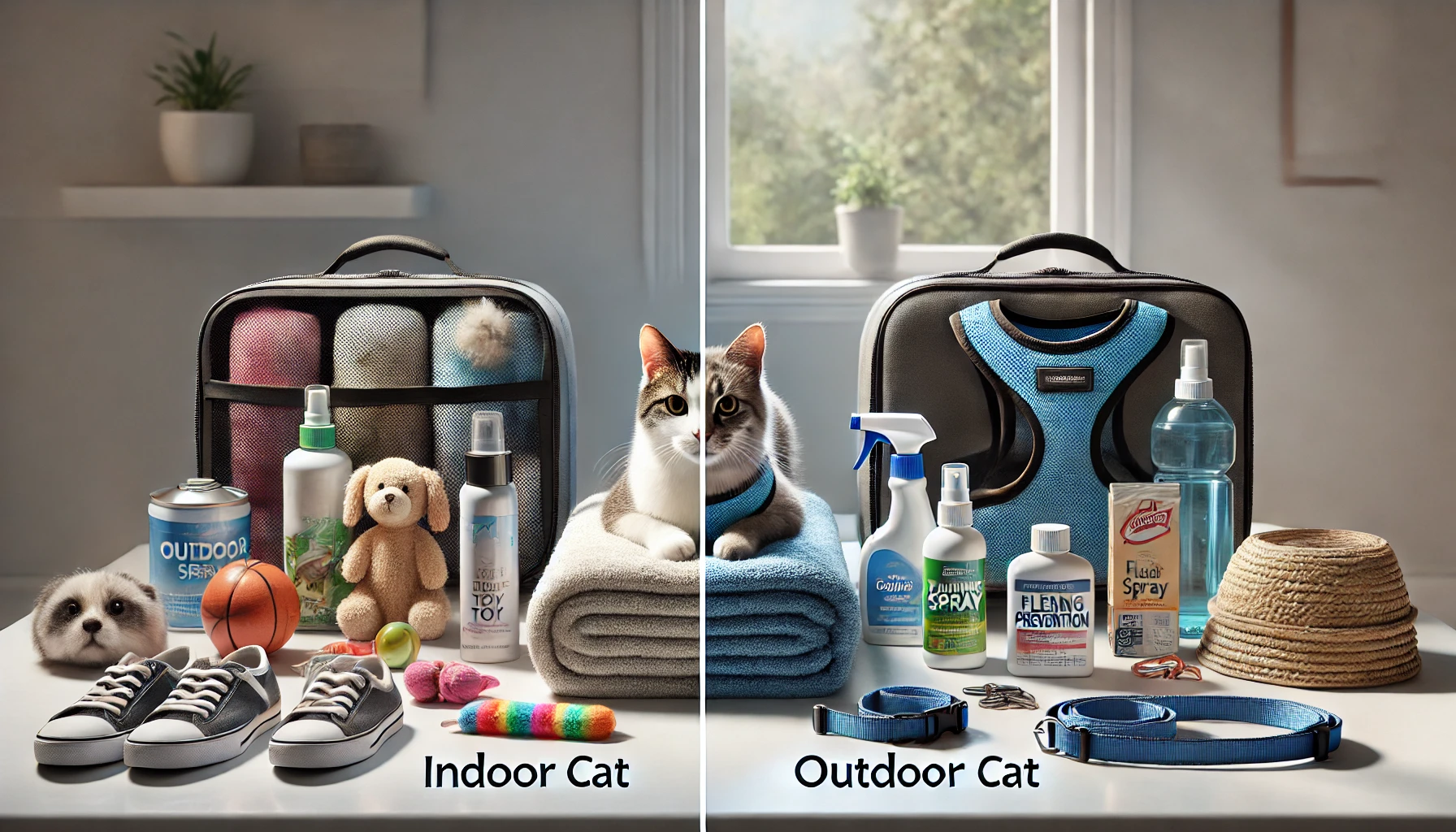
Indoor vs Outdoor Cats: What to Pack
Whether your cat is primarily indoors or enjoys spending time outdoors will also affect what you pack.
Outdoor cats may need more safety gear, like harnesses and leashes, while indoor cats may need more comfort items to ease their anxiety in unfamiliar places.
Here are some recommendations for packing cat essentials based on your cat’s lifestyle:
- Indoor cat: Comfort items such as a favorite blanket or toys. Anxiety-reducing sprays are also appropriate for indoor cats.
- Outdoor cat: Take a harness and leash with you so that your cat can safely explore the outdoors. You may also want to add flea and tick prevention medication to your list to keep your cat protected.
Packing the right cat essentials is key to ensuring your cat’s comfort during any trip. Here’s what you need to focus on when preparing for travel with your feline companion.
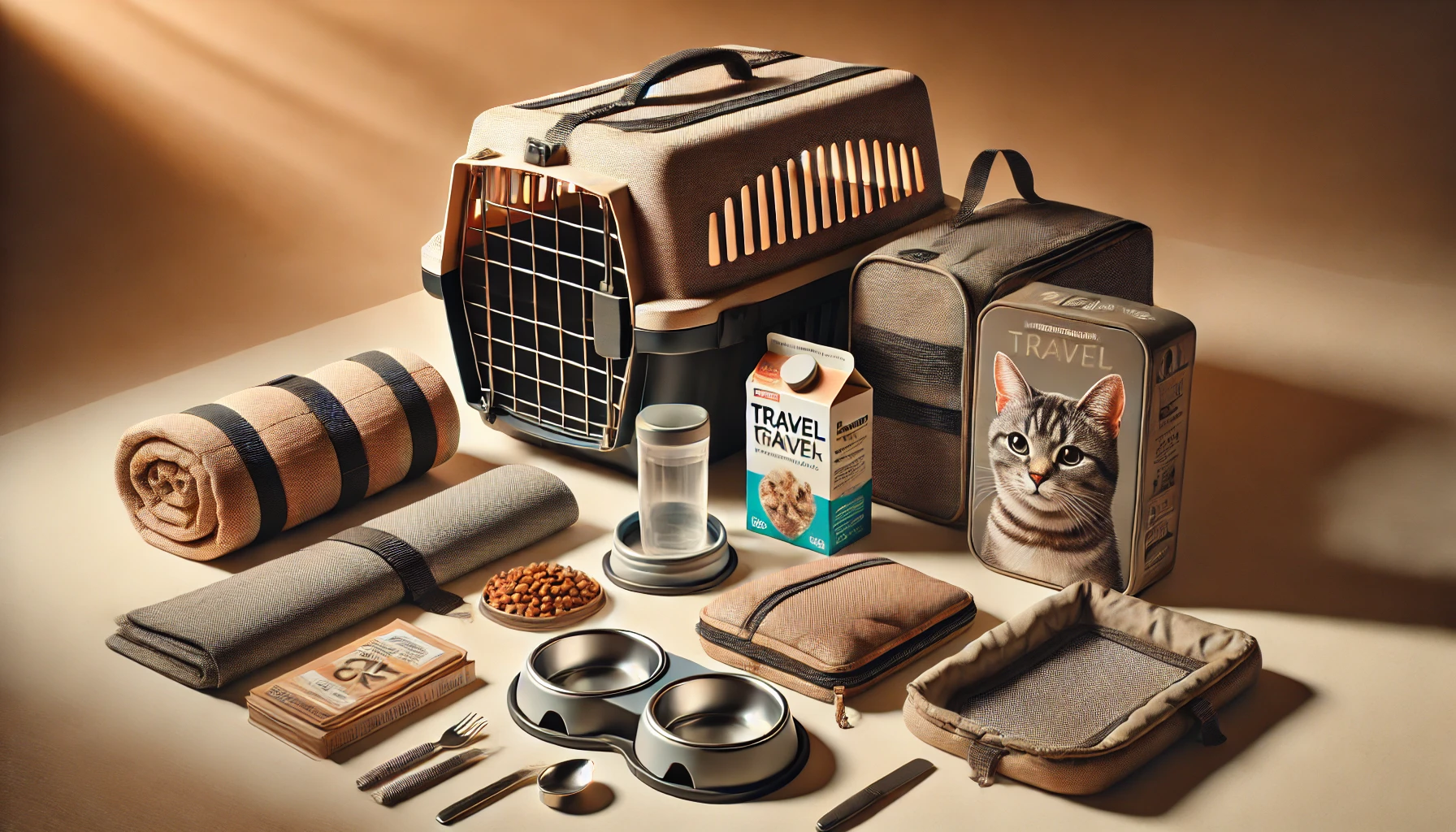
Essential Cat Travel Gear
Regardless of your cat’s individual needs, there are some cat essentials you should bring whenever you travel.
These items can make the trip simpler and far safer, not only for your cat but for you as well:
- Travel Carrier: It is necessary for any trip and should be safe and comfortable. It should be large enough for your cat to stretch in, including being able to stand up, lie down, and turn around. Make sure it is well-ventilated.
- Food and water bowls: Consider collapsible bowls that are easy to clean and take the least room in your luggage.
- Litter box: If your journey lasts more than a couple of days, you might wish to bring a lightweight portable litter box that is easy to clean and carry around.
- Identification tags: Always make sure that your cat is wearing proper identification in case they escape during your trip.
Some essential gear is a must for any trip, such as a travel carrier, food and water bowls, and a portable litter box to ensure a smooth journey.
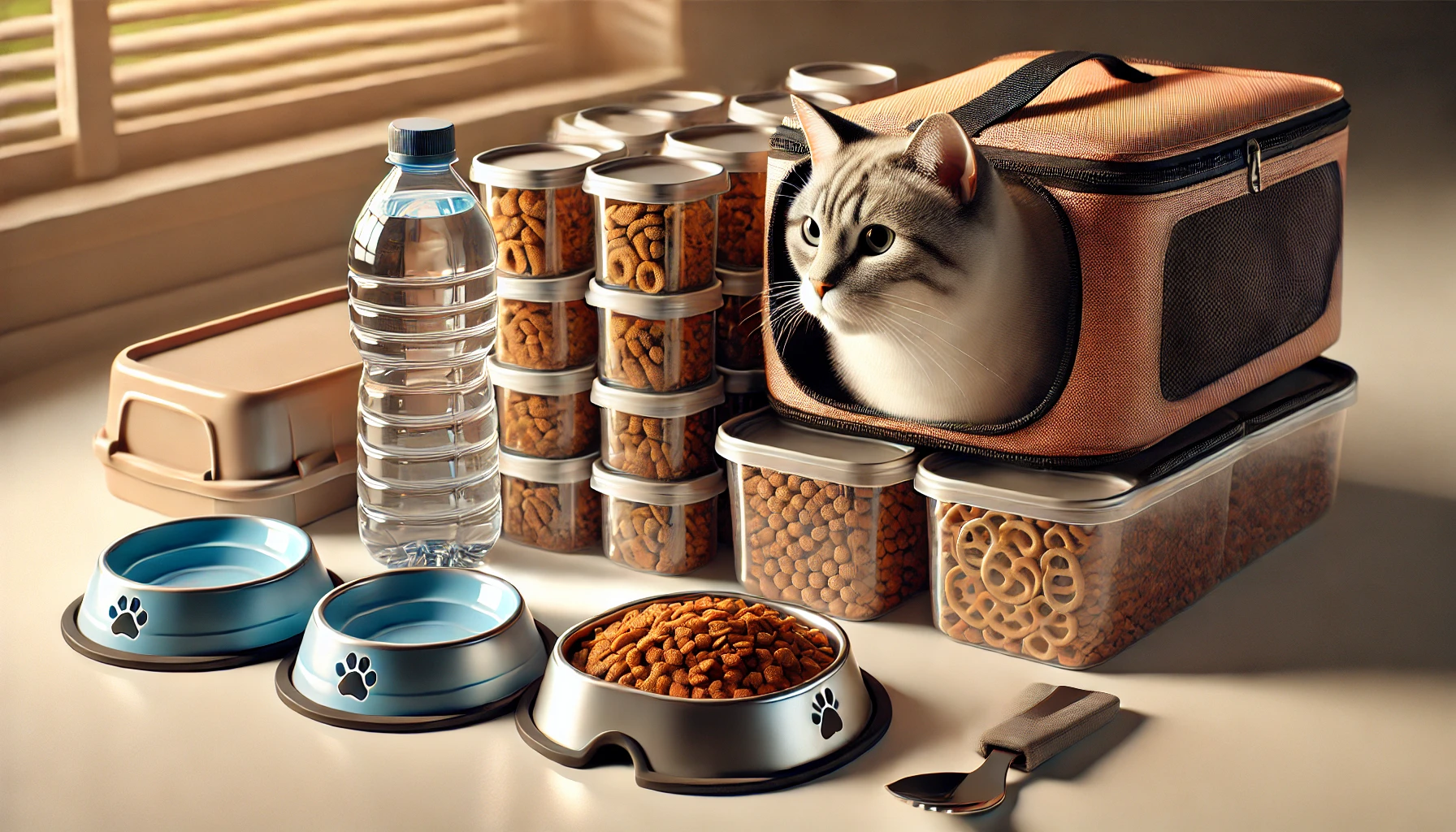
Packing Food and Water for a Stress-Free Journey for Your Cat
One of the most important things that must be considered while traveling is to have your feline friend adequately fed and hydrated to maintain their health and well-being.
The nature of cats is very sensitive, and even minor changes in diet or slight adjustments in the feeding schedules may lead to stress for them, accompanied by problems in digestion.
Packing the proper cat essentials for travel food and hydration will ensure your feline friend is as comfortable and nourished as possible during your travel.
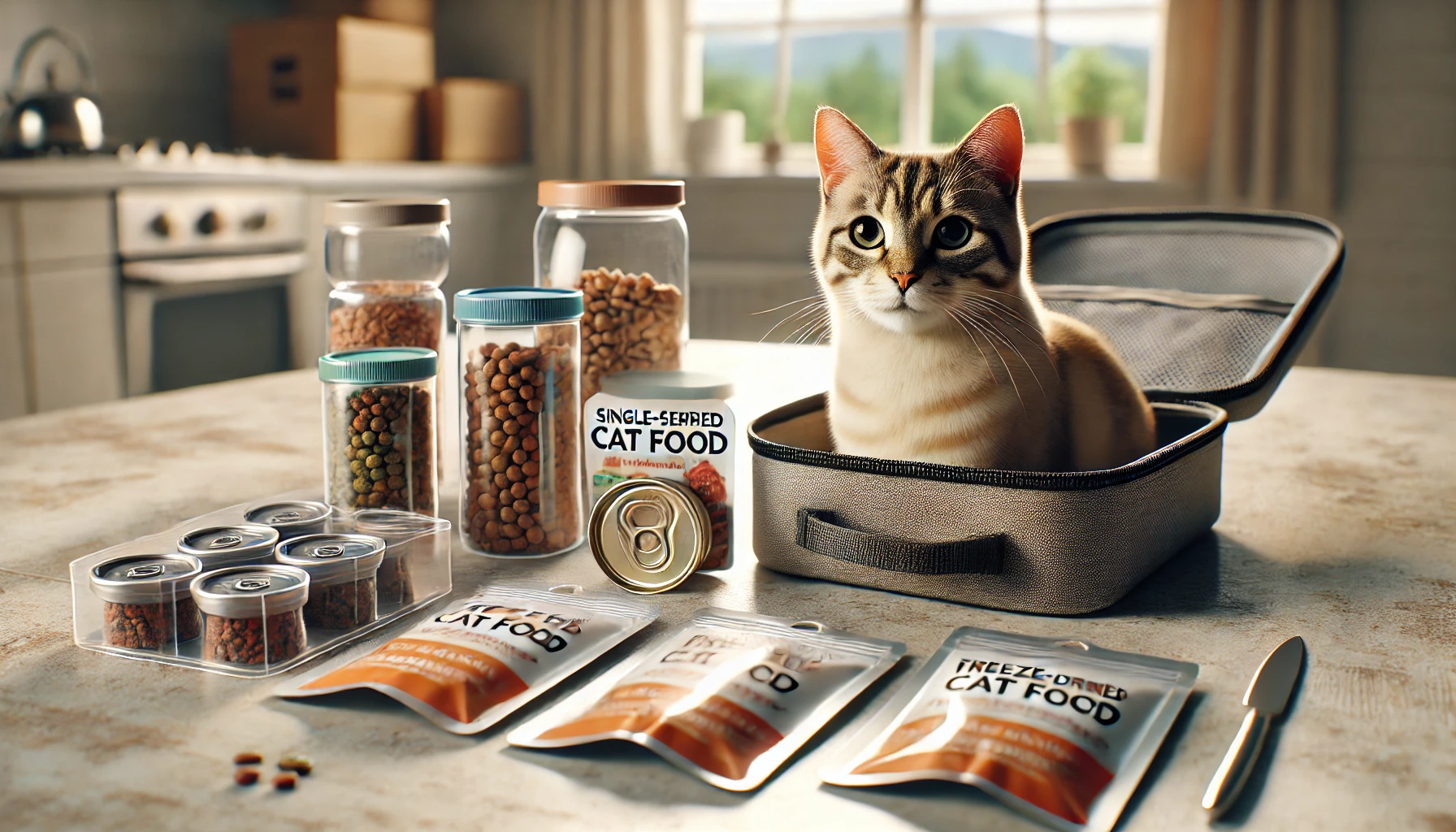
Picking Travel-Friendly Cat Food
While traveling, it is best to keep with food that your cat is already accustomed to.
Changes in food can bring about problems in digestion, and you certainly would not want that during a trip.
Here are some useful tips for packing travel-ready food for your cat:
- Pre-package your cat’s usual dry or wet food: Bring enough food for the duration of the whole trip and a little more in case of delays or changes of plans. Wet food should be packed in single-serving pouches to reduce wastage and to make feeding easier when on the go.
- Airtight containers: Store cat food in airtight containers to retain freshness. This helps prevent spills and keeps the food’s scent from attracting other animals.
- Freeze-dried varieties: Freeze-dried cat food is a good option for longer trips. It’s lightweight, takes up little space, and can be rehydrated with water at feeding time.
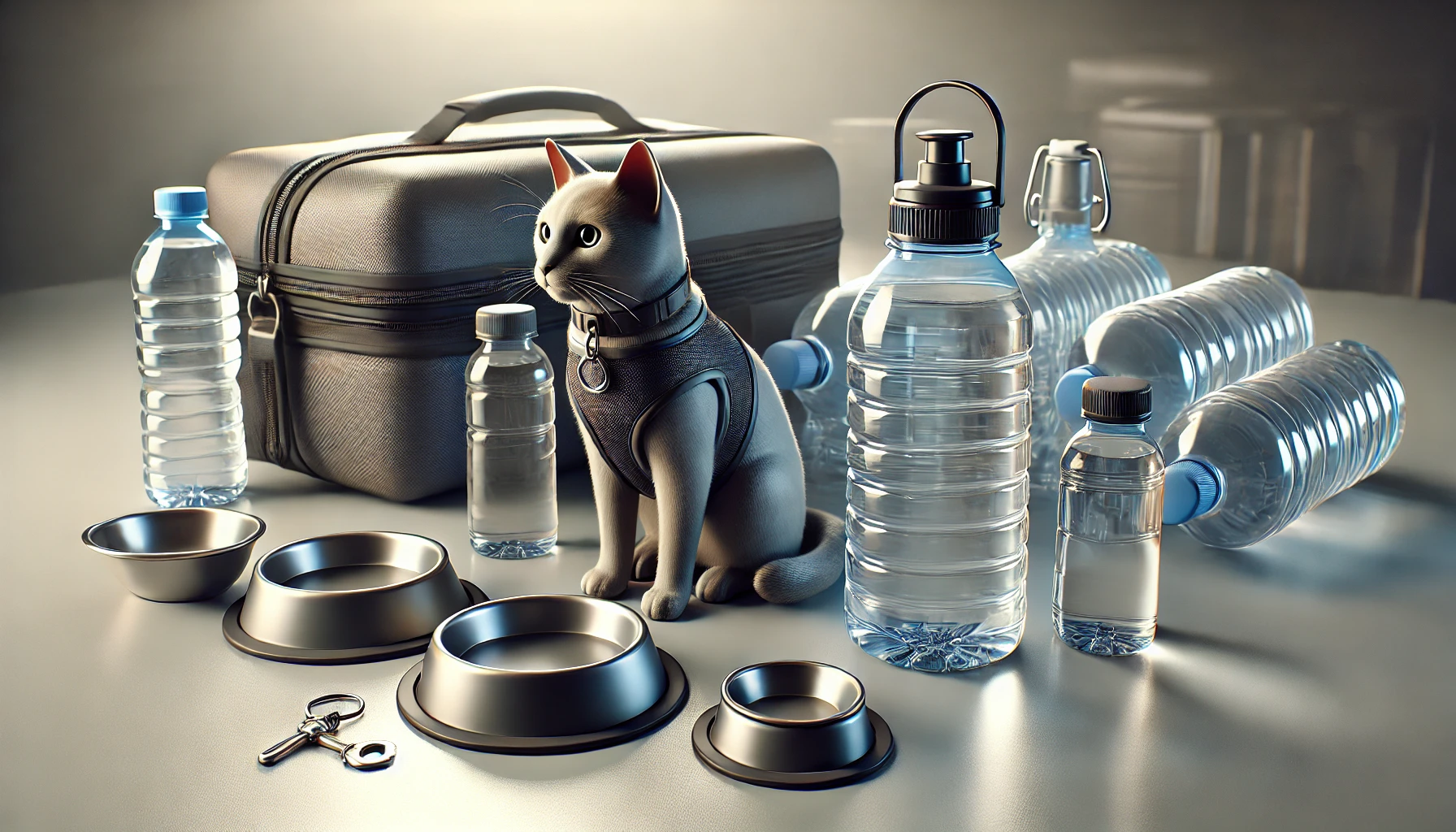
Packing Water and Hydration Supplies
Hydrating your cat through the journey is just as important as feeding.
Cats can be very particular about their water source, so it’s always best to bring their usual water or filtered water to avoid issues where the cat refuses to drink.
Here’s how you can ensure that your cat is properly hydrated:
- Bottled or filtered water: Cats can be sensitive to changes in the taste of water. If you’re traveling to a region with different mineral content in the water, it’s best to err on the side of caution and use bottled or filtered water.
- Collapsible water bowls: Lightweight and easy to pack, collapsible bowls are great for any trip. Opt for BPA-free, non-toxic products that are easy to clean.
- Pet water bottle: Travel bottles with attached bowls are specially designed for pets. These allow your cat to drink on the go without creating a mess.
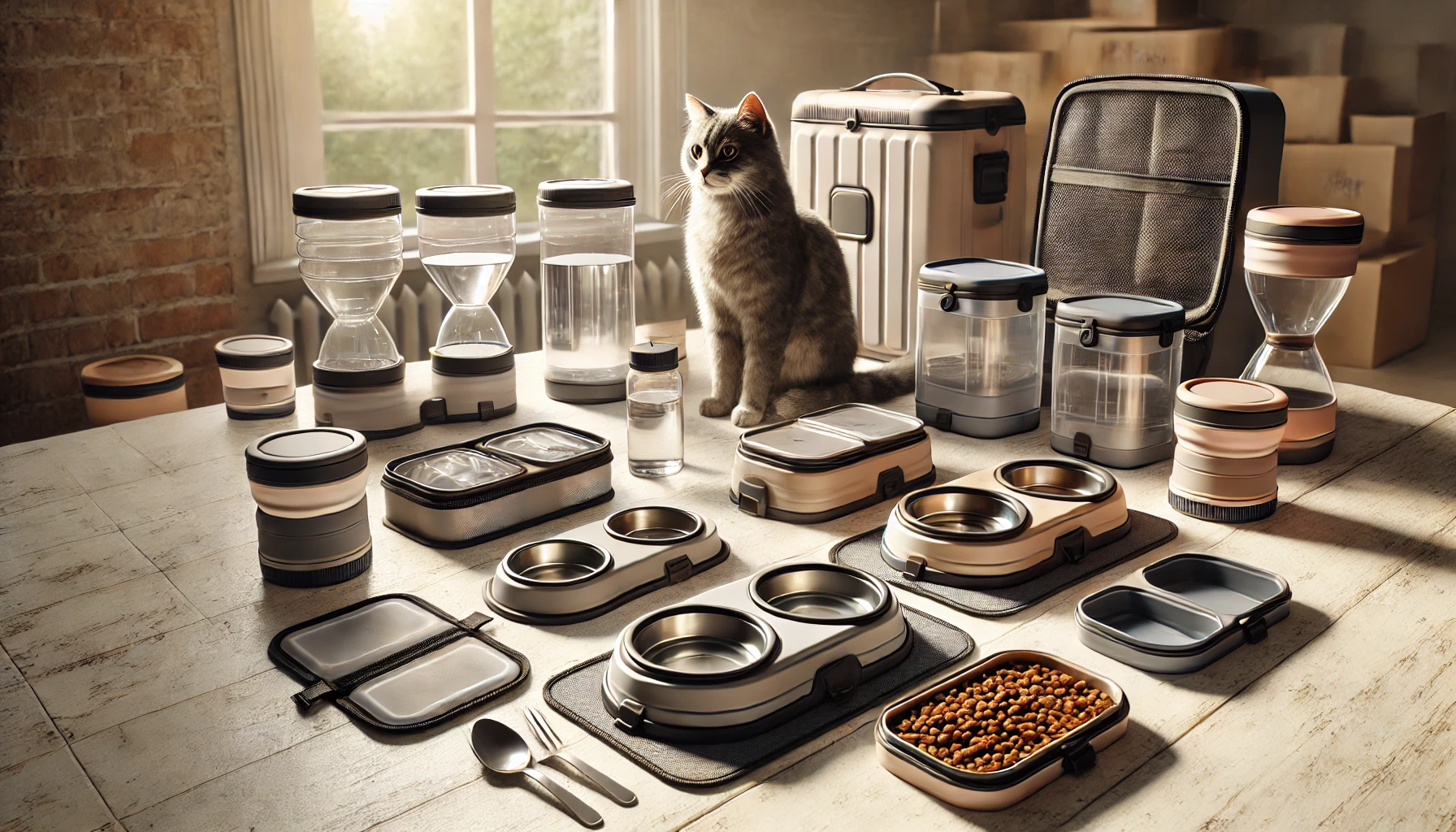
Food and Water Containers On-the-Go
Having the right containers for your cat’s food and water will help keep everything organized and accessible.
Here are a few travel-friendly options:
- Collapsible bowls: These space-saving bowls are perfect for both food and water, making them a great addition to your cat travel kit.
- Portable feeding stations: These compact, foldable units combine both food and water bowls in one. Many come with lids or covers to prevent spills during transport.
- Food storage containers: Airtight food storage containers are crucial for keeping your cat’s food fresh. Choose BPA-free containers that are travel-ready and easy to pack.

Long-Distance Snacks and Treats
Bring along a few of your cat’s favorite treats or snacks to help diffuse anxiety during the ride—or to reward them for good behavior.
Be careful with the kind of treats you pack:
- Healthy, low-calorie treats: Choose treats that are low in calories but high in protein to keep your cat energized without overfeeding.
- Treats in resealable bags: Opt for treats that come in resealable bags to maintain freshness and prevent spills in your luggage.
- Interactive treats: Consider treats that double as toys—like treat balls or puzzle feeders—to keep your cat entertained during the journey.
Ensure your cat has enough food and water during the trip. Maintaining familiar feeding schedules and packing sufficient supplies is critical for reducing stress.

Essential Comfort Items to Bring Along for Cats on the Go
Traveling with your cat may be very distressing for the animal.
However, with the appropriate comfort items, your journey can be quite pleasant and soothing for them.
The key lies in bringing along familiar objects with which your cat associates home.
These cat essentials reduce anxiety and make your cat feel safe and secure throughout the journey.
Let’s go through some of the cat essentials that provide comfort to your feline companion during travel.

Bringing Familiar Bedding and Toys
Cats are also creatures of routine.
A cat will feel much more comfortable knowing familiar smells are around them.
Bringing along favorite bedding and toys can provide comfort in a new environment.
Here are some ways to ensure your cat stays comfortable:
- Favorite bedding: Pack your cat’s regular bed or a blanket on which they frequently sleep. The familiar scent will be a source of comfort during the journey and help them adjust to new environments.
- Toys: Bring some of your cat’s favorite toys to keep them entertained and occupied. Soft toys with familiar smells can reduce stress and provide comfort.
- Interactive toys: Consider packing interactive toys, like puzzle feeders or teaser wands, to keep your cat engaged and relaxed during the trip.
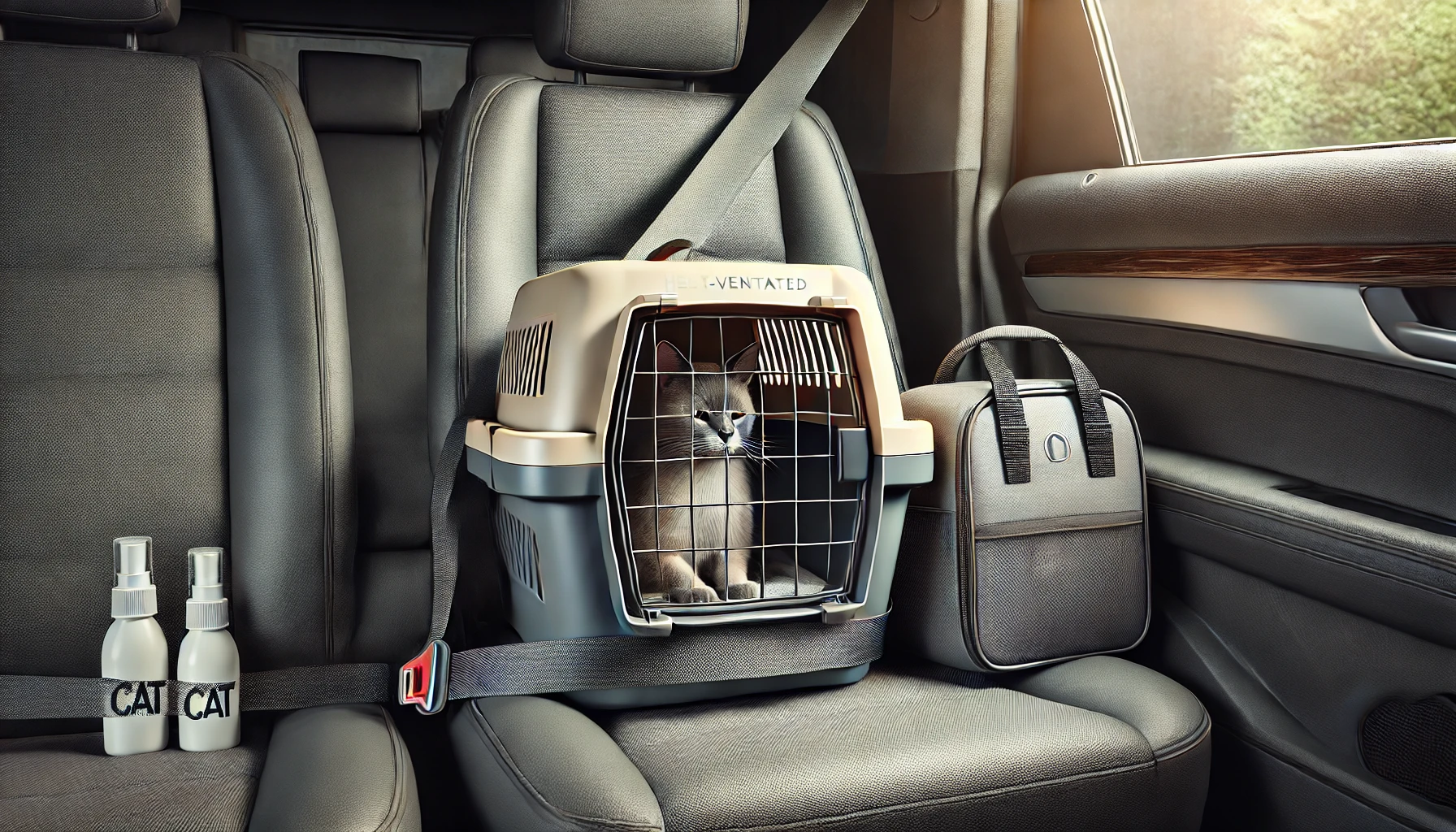
Using Carriers and Travel Bags Safely
One of the most important cat essentials for your trip is a comfortable and secure carrier.
It not only keeps your cat safe but also provides a space where they can relax.
Here’s what you should know about choosing and using carriers:
- Choose the right carrier: Find a sturdy, well-ventilated carrier that’s large enough for your cat to stand up, turn around, and lie down comfortably. Soft-sided carriers are great for car journeys, while hard-sided carriers provide more protection on longer trips.
- Line the carrier with soft bedding: Line the carrier with a blanket or bedding with a familiar scent to provide extra comfort. This helps your cat feel secure even in unfamiliar environments.
- Secure the carrier: Secure the carrier with a seatbelt while driving to prevent it from sliding. This will keep your cat safe and reduce anxiety caused by sudden movements.
- Use pheromone sprays: Spraying the carrier with a pheromone spray, like Feliway, can help reduce stress. These sprays mimic natural cat pheromones that have a calming effect, making the carrier a more reassuring space.
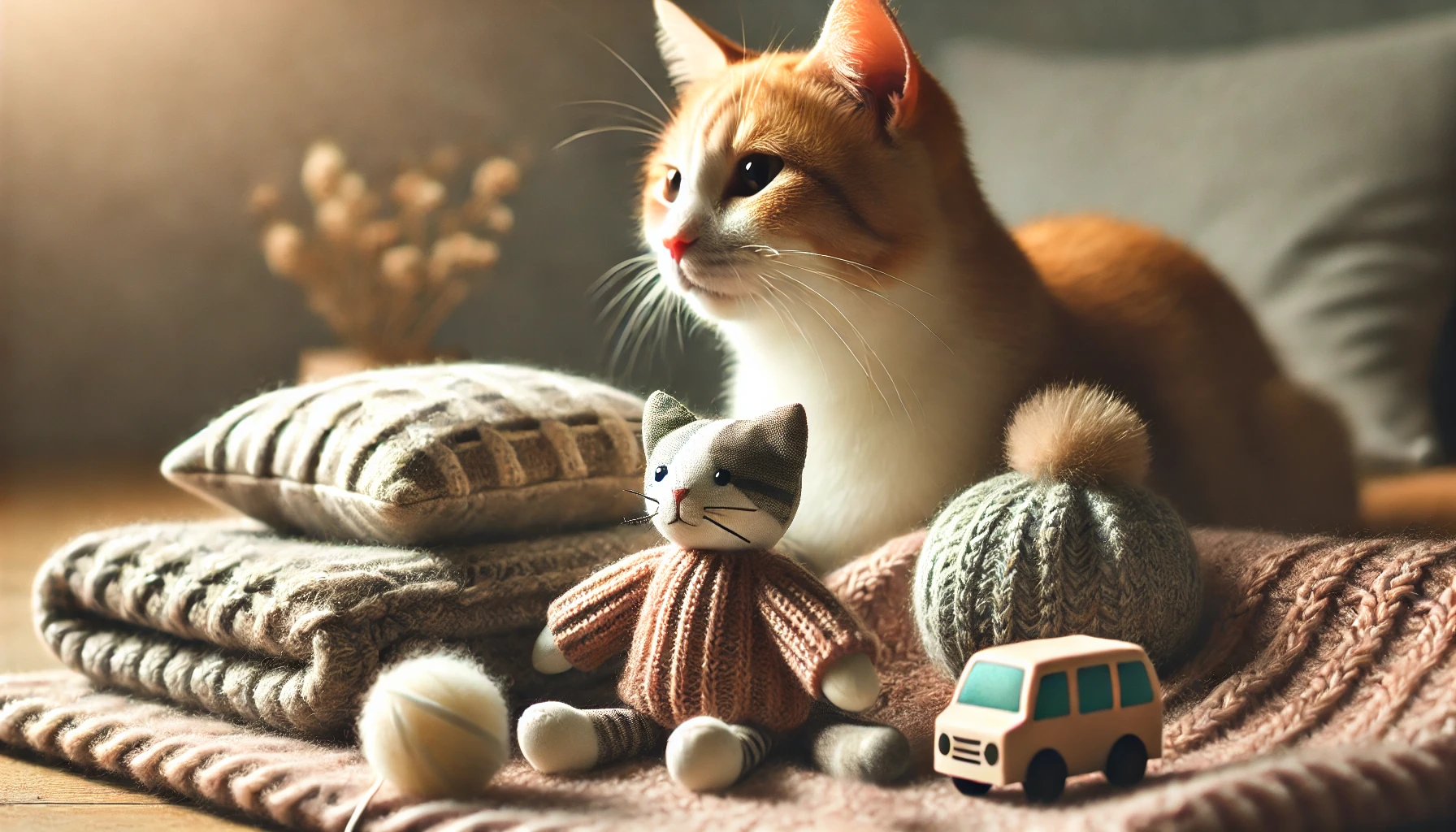
Comforting Your Cat with Familiar Scents
Cats rely heavily on their sense of smell, and familiar scents can be very comforting in unfamiliar environments.
Here’s how to help your cat feel more secure using scents:
- Bring items with home scents: Pack a few items from home, such as your cat’s favorite blanket or a worn shirt that carries your scent. These familiar smells can help soothe your cat and reduce travel-related stress.
- Use pheromone sprays or diffusers: Pheromone sprays or diffusers can create a calming environment for your cat, both in the carrier and at your destination.
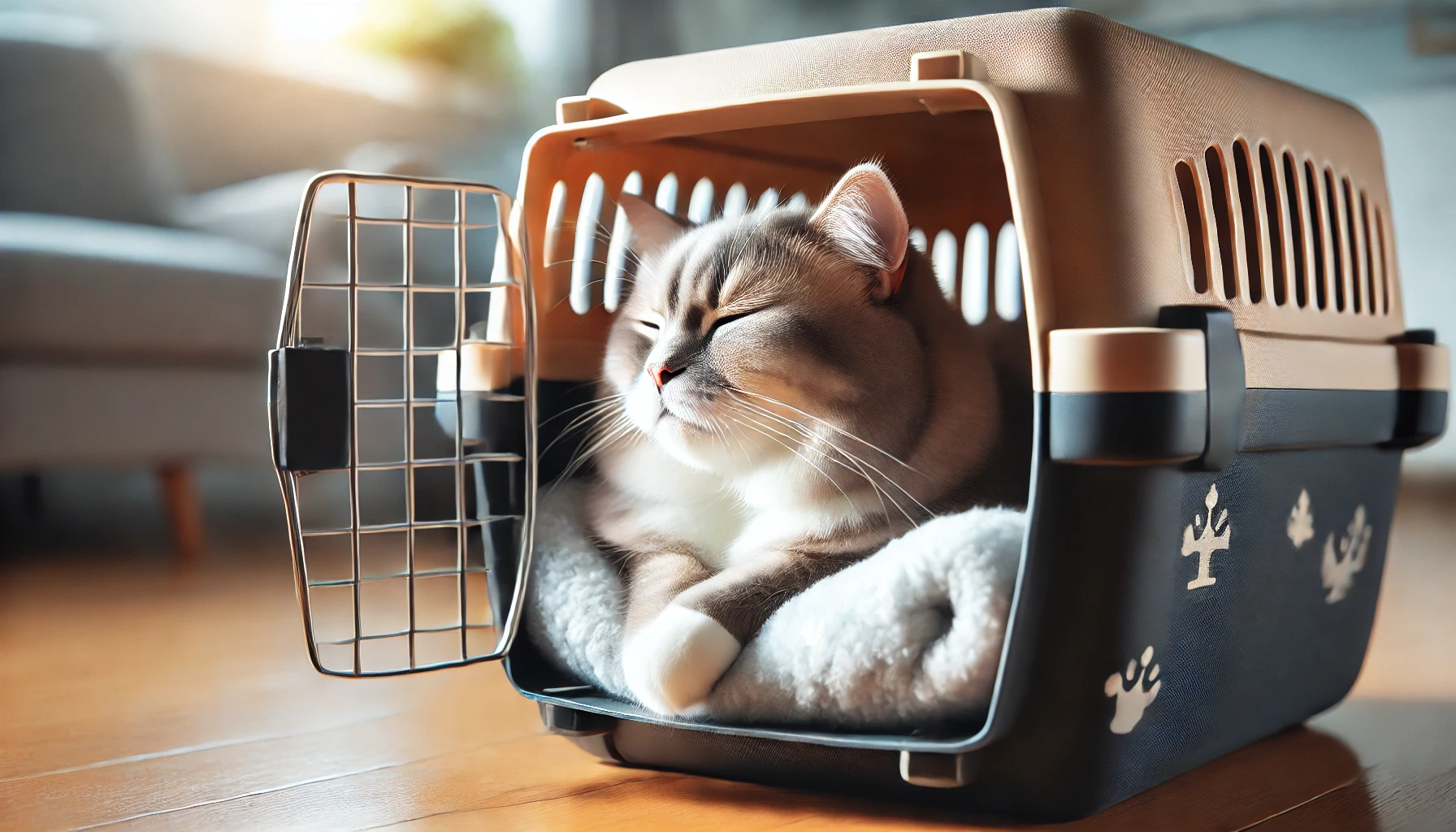
How to Keep Your Cat Calm While Traveling
Keeping your cat calm during travel is important for both their well-being and yours.
While most cats will need some time to adjust, others may feel more anxious.
Here are some tips to help your cat stay calm:
- Practice short trips: Take your cat on short drives before the longer journey to help them get used to the experience. This can reduce anxiety when it’s time for the bigger trip.
- Keep the environment quiet: Cats are sensitive to noise, so keep the car or travel environment as quiet as possible. Playing soft music or maintaining silence can help create a calming atmosphere.
- Keep routines similar: Stick to your cat’s regular feeding and play schedule as much as possible while traveling. Familiar routines provide comfort and stability.
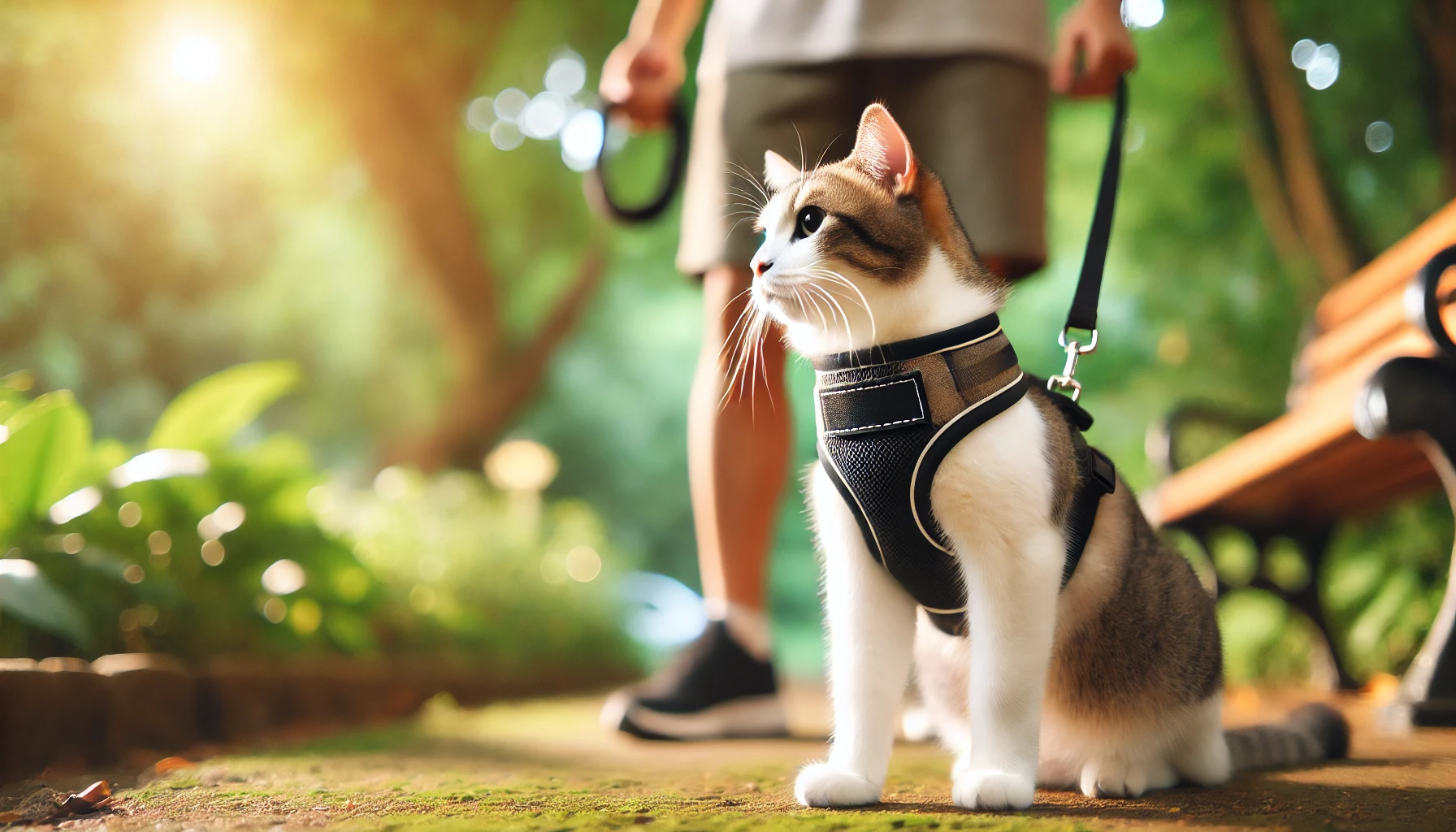
Safety First: Traveling with Leashes and Harnesses
If your cat is adventurous and needs some outdoor time during the journey, using a harness and leash is essential.
It allows your cat to explore safely.
Here are some considerations for packing these cat essentials:
- Choose a safe harness: Bring a well-fitted harness that your cat is used to wearing. Practice with the harness before the trip to ensure your cat is comfortable with it.
- Leash training: If your cat isn’t leash-trained yet, consider starting training before the trip. A well-trained cat on a leash can explore outdoors safely without the risk of running away.
- Pack an extra leash: Always carry a backup leash in case the primary one gets damaged or lost during the trip.
Comfort items such as familiar bedding, toys, and calming sprays can significantly reduce your cat’s anxiety during travel.
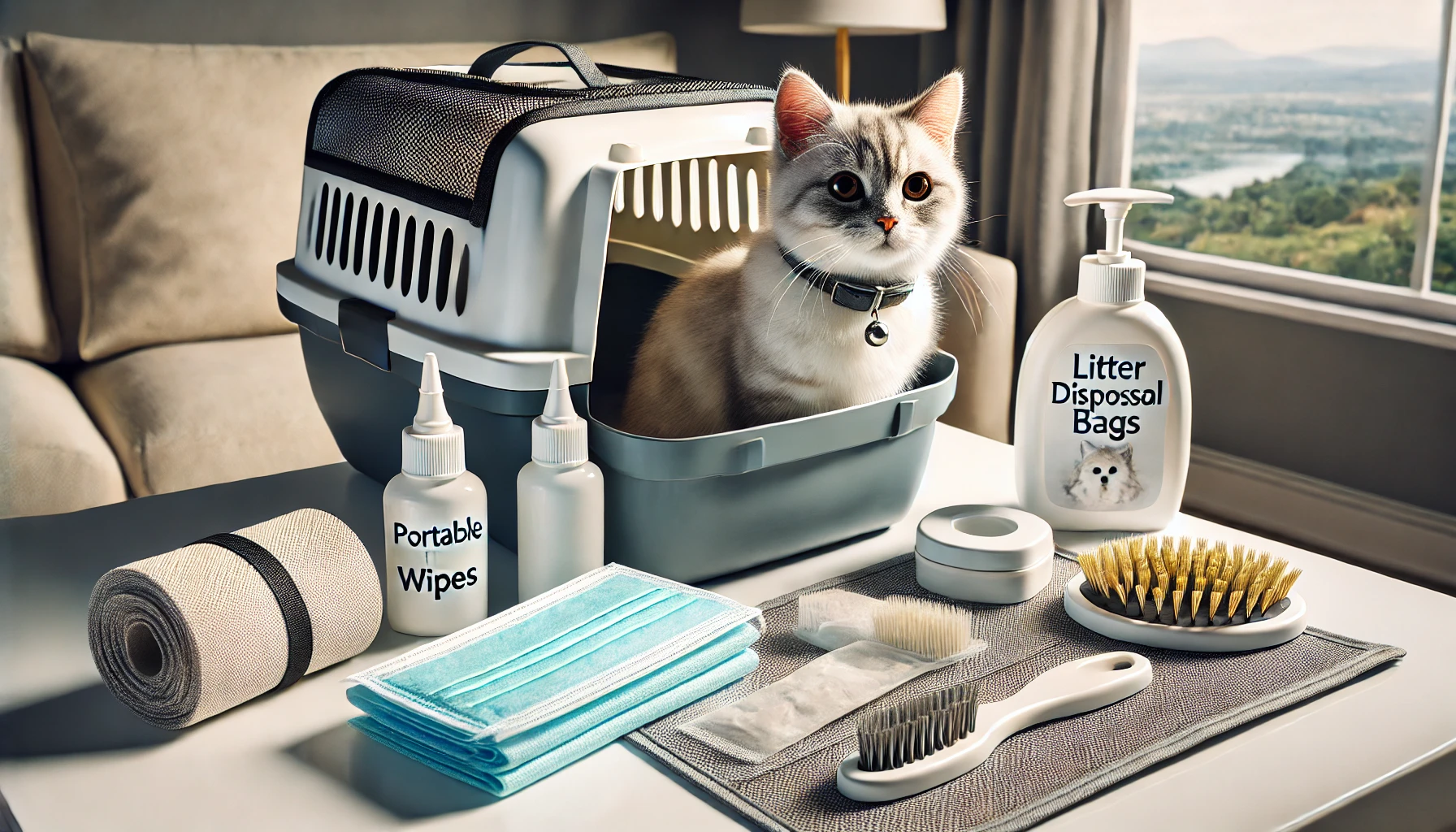
Cat Hygiene Essentials for Trips
Keeping your cat hygienic on the trip is important, just like making them comfortable.
Cats are naturally tidy animals, and changes in their surroundings may sometimes cause anxiety that could impact their grooming.
The proper hygiene cat essentials will keep your cat clean, healthy, and relaxed on your journey.
Let’s dive into some major hygiene items you will want to pack for your cat on your trip.
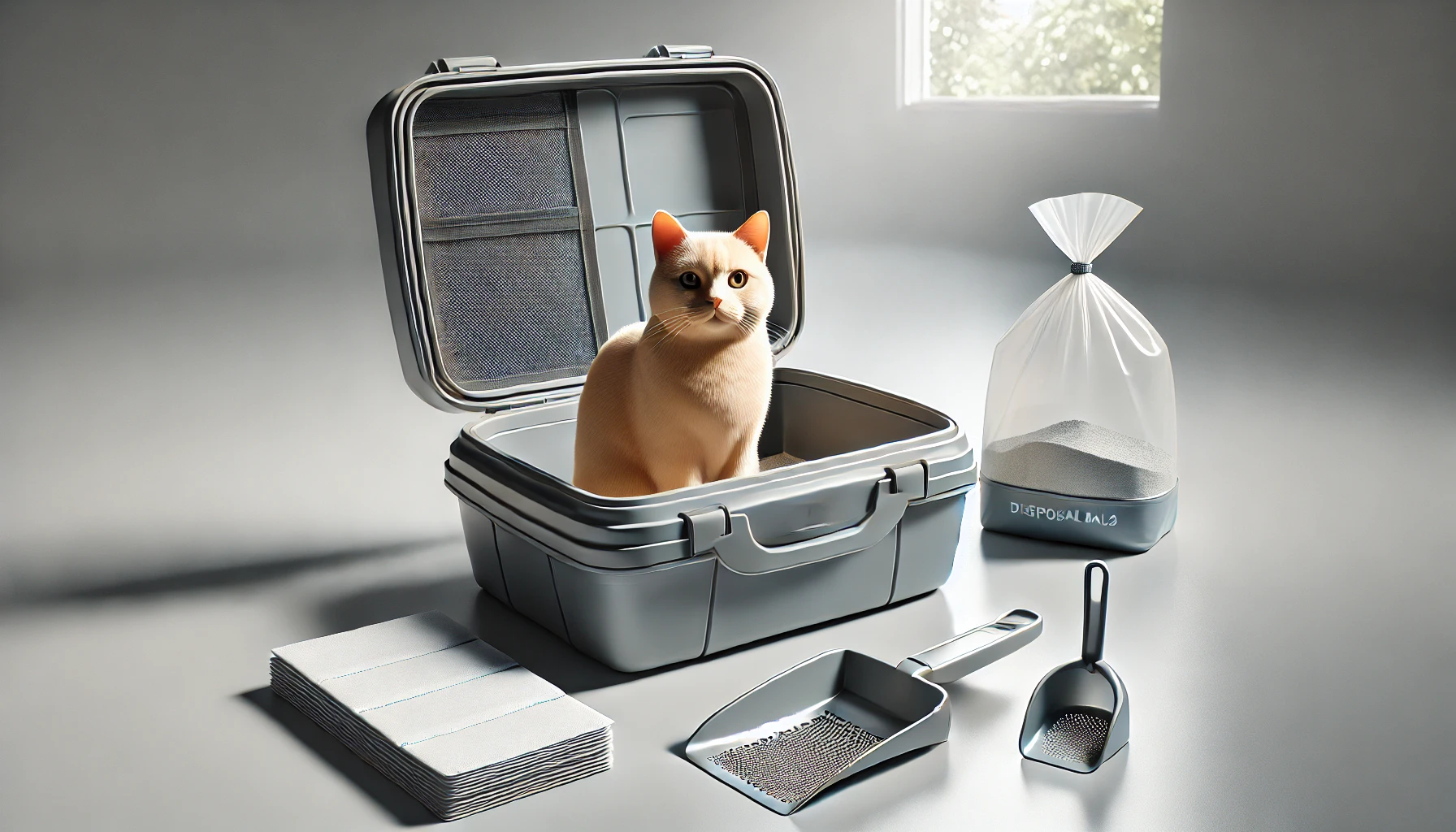
Portable Litter Boxes and Disposal Bags
Among the essential cat accessories for any form of travel is a portable litter box.
Cats are known to be fussy about their litter, and maintaining a familiar setup is important to keeping your cat’s stress levels low and ensuring their hygiene.
Here are some guidelines on how to select and use a portable litter box:
- Foldable or disposable litter boxes: These are lightweight and easy to carry. They can be easily arranged in hotel rooms, cars, or wherever you stop.
- Litter disposal bags: Always carry enough litter disposal bags to clean up after your cat. Odor-sealing bags are a great invention for eliminating unpleasant smells, making them a must on long trips.
- Extra litter: Remember to pack a small bag of your cat’s regular litter. Cats are not good with change, so familiar litter from home will be a comforting touch in a new environment.
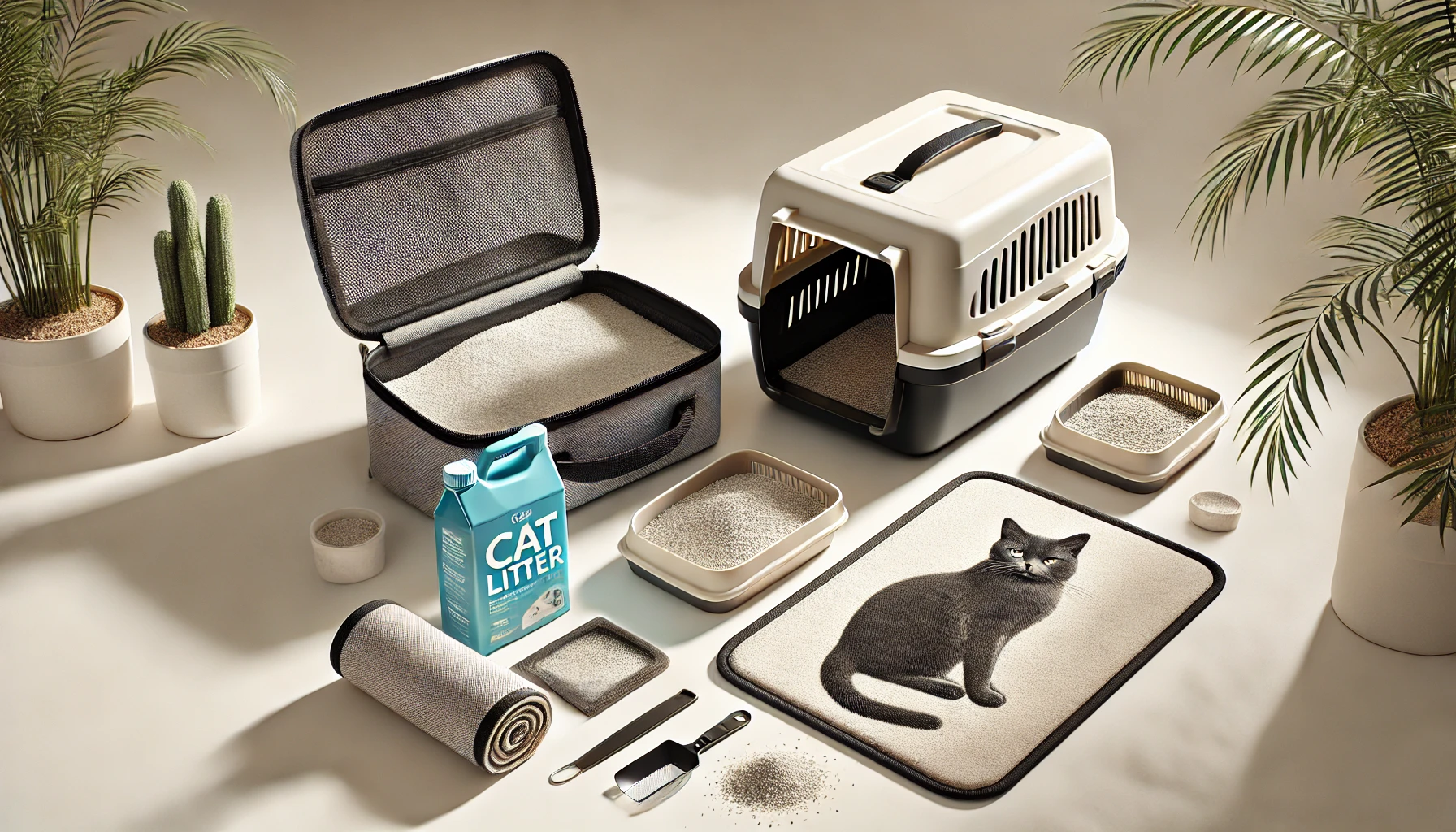
Packing Litter and Litter Mats
Packing enough litter and a litter mat will help maintain a clean area throughout the journey.
Litter mats reduce the mess caused by litter scattering, keeping your travel space tidier.
Here’s how to effectively pack litter when traveling:
- Compact litter mats: Pack a foldable litter mat to place under the litter box to catch stray litter and keep your cat’s area clean.
- Odor-absorbing litter: Use odor-absorbing litter to minimize smells during travel. Clumping or silica-based litter is a convenient choice for easy cleaning.

Grooming Supplies: Brushes and Wipes
Grooming is very important for your cat’s hygiene and should not be compromised just because you are traveling.
Carrying a few necessary grooming items will keep your cat looking and feeling their best during the journey.
Here are the essential grooming cat accessories to pack:
- Brush or comb: Bring your cat’s regular brush or comb, especially if you have a long-haired cat, to manage shedding and prevent matting. Regular brushing also helps reduce hairballs.
- Pet-safe wipes: These are great for quick cleanups, especially if your cat gets dirty during the trip. Wipes can also freshen up your cat’s coat without needing a full bath.
- Nail clippers: In case of emergencies or if your cat’s nails need trimming during the trip, pack a pair of cat-safe nail clippers to maintain their grooming routine.
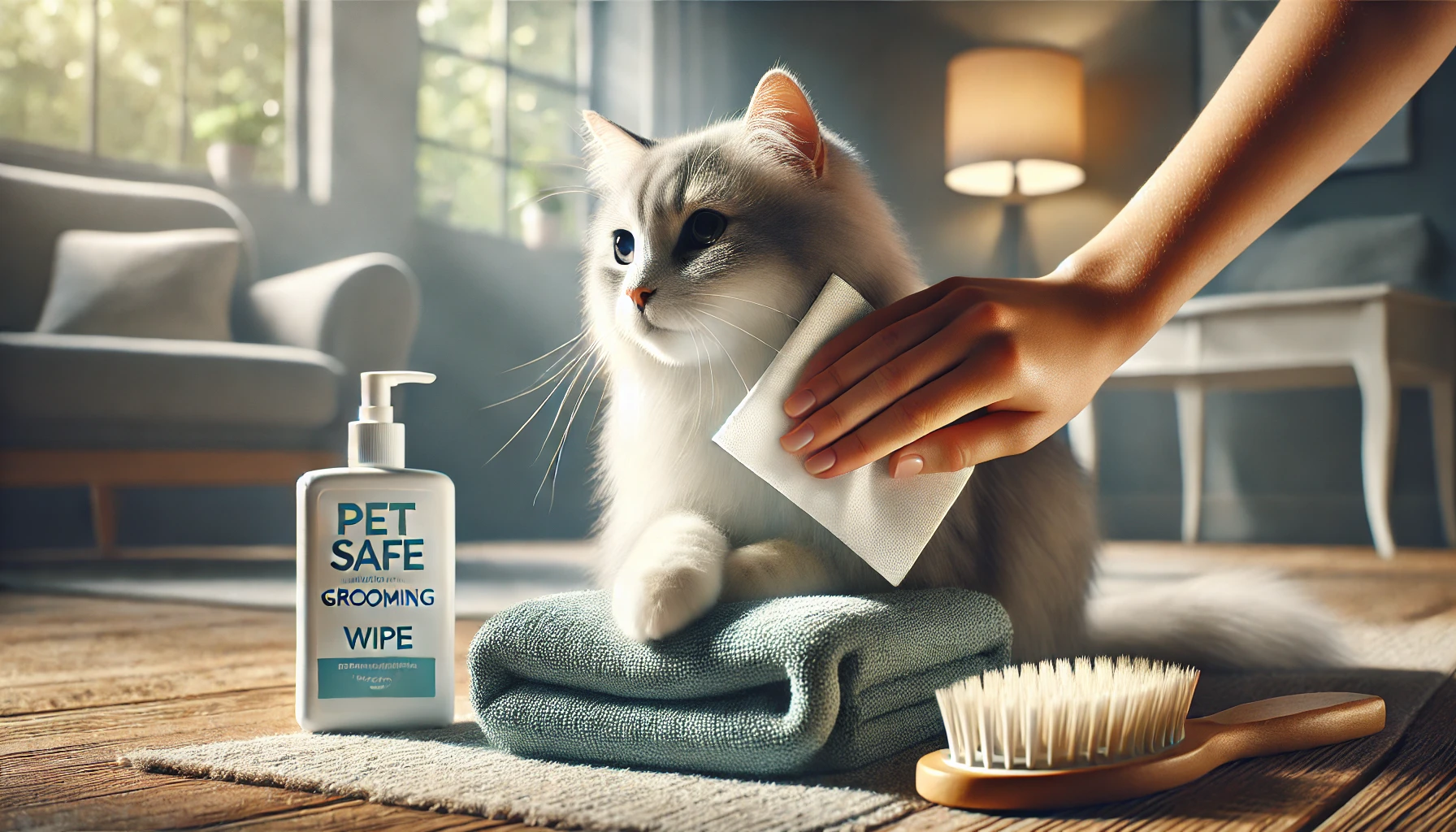
Keeping Your Cat Clean and Comfortable on the Go
Travel can be unpredictable, so it’s important to be prepared for any messes that might occur along the way.
Keeping your cat clean will help them feel comfortable and minimize travel-related stress.
Here are some tips for keeping your cat clean while on the go:
- Extra towels: Take a couple of small towels to clean up spills or minor accidents during transit and to wipe down your cat if they get dirty.
- Packing a grooming kit: Pack a travel-sized grooming kit with essential items like brushes, wipes, and clippers to help keep your cat clean and comfortable. Don’t forget a lint roller to keep your belongings fur-free.
- Portable litter box liners: Use litter box liners to make cleaning the litter box easier. These can be quickly discarded and replaced with minimal fuss.
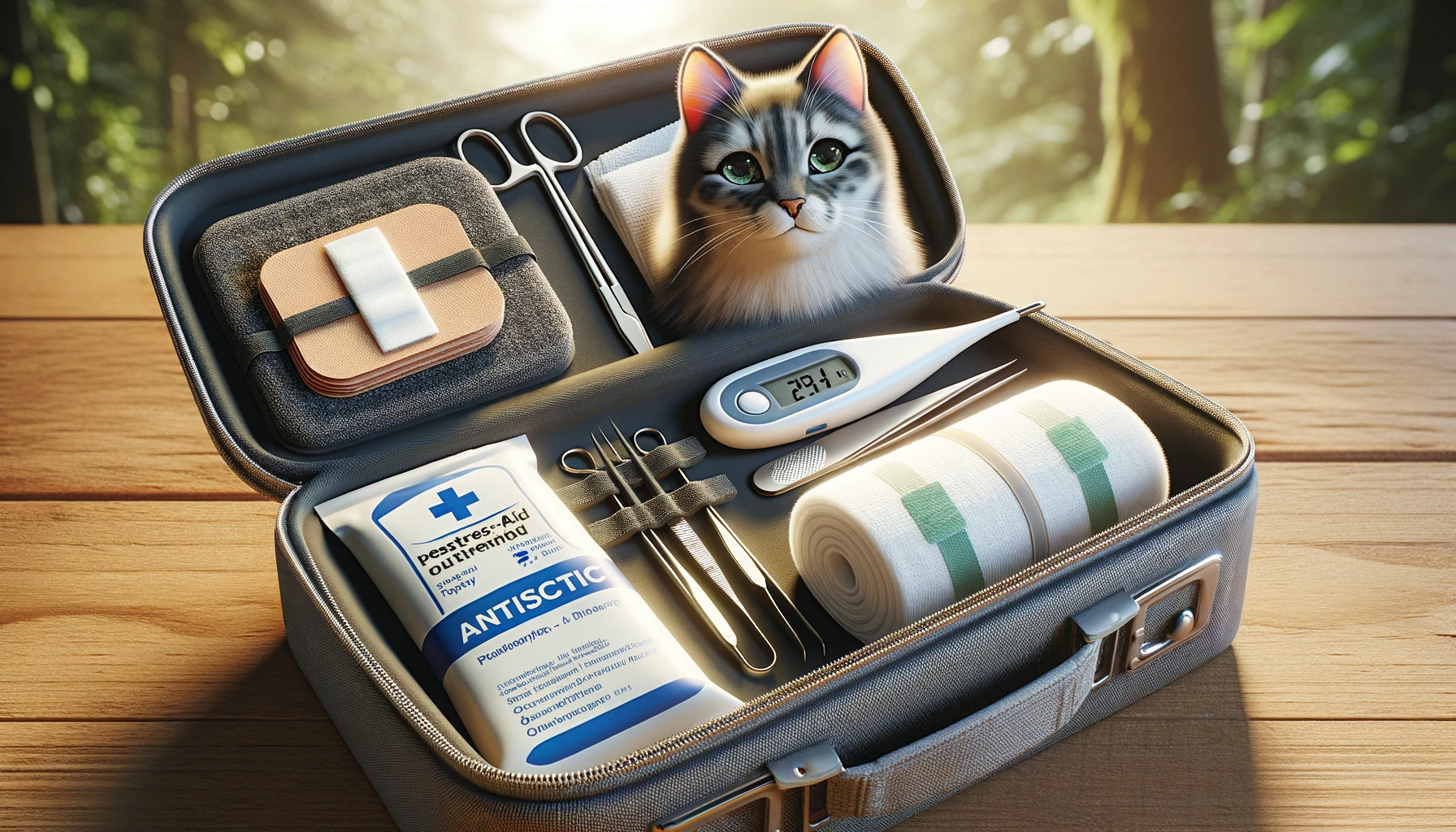
How to Pack a First-Aid Kit for Your Cat
Having a first-aid kit ready for your cat is an important component of preparing for any trip.
Like humans, cats can get minor injuries or health issues during travels, and having the right cat essentials with you will ensure you’re prepared to take care of them.
A well-stocked first-aid kit can help you handle emergencies and prevent any existing conditions from worsening.
Let’s go through what you need to include in a first-aid kit for your cat.
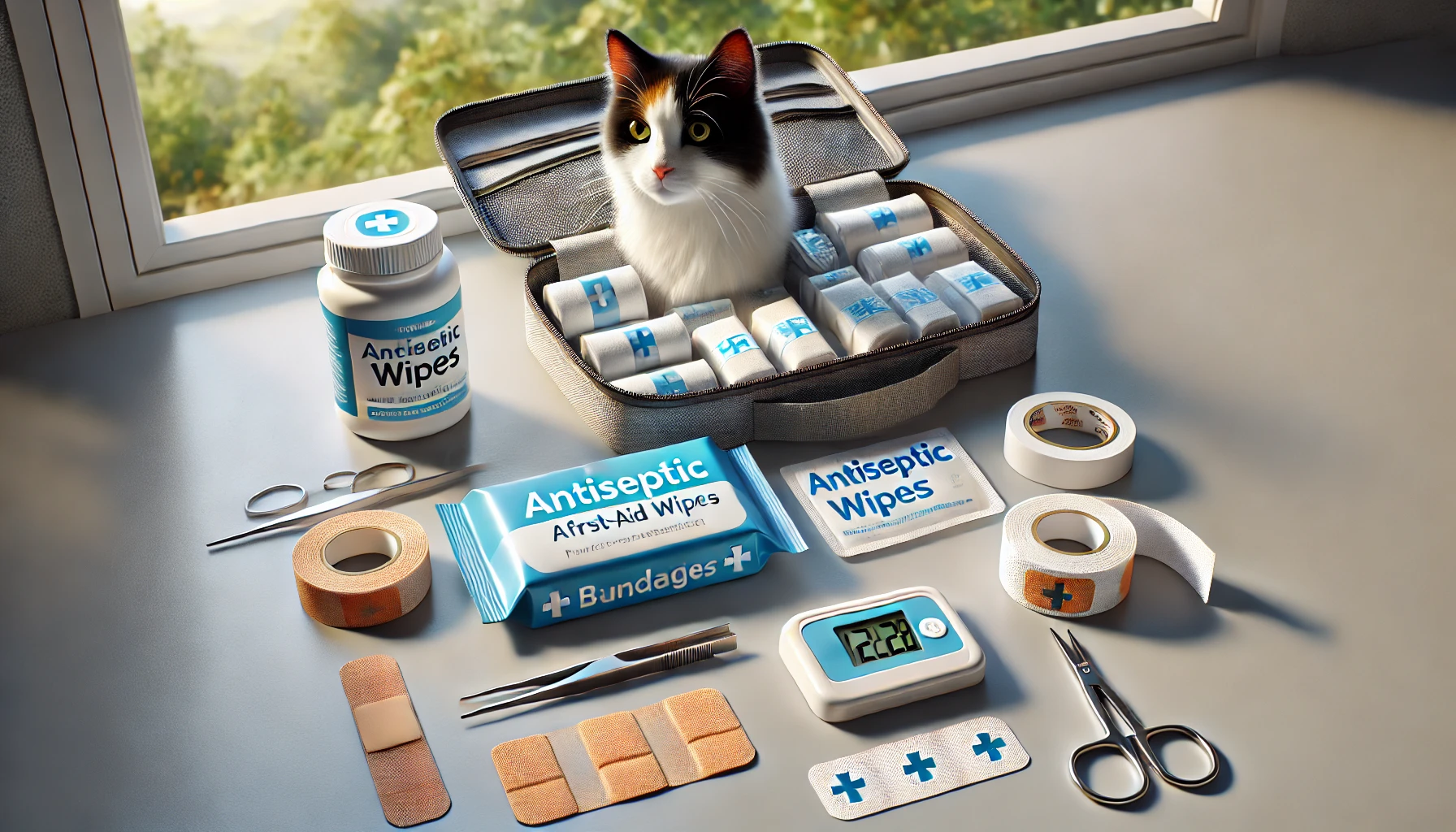
Basic Medical Supplies to Include
A basic first-aid kit for your cat will include items that are useful in treating minor injuries and common health issues.
The following are some of the most important supplies to pack:
- Bandages and gauze pads: These are necessary in case of minor cuts or scratches. Be sure to have self-adhesive bandages that don’t stick to your cat’s fur.
- Antiseptic wipes or solution: Clean lesions, cuts, or wounds with a non-toxic antiseptic solution before wrapping them with a bandage. Avoid using products that contain hydrogen peroxide or alcohol, as they can further irritate your cat’s skin.
- Tweezers: Tweezers are handy for removing splinters, ticks, or other small foreign objects that may find their way into your cat’s fur or paws.
- Pet-safe adhesive tape: This is useful for holding gauze or bandages in place in a way that won’t irritate your cat.
- Digital thermometer: A thermometer designed for pets will allow you to check your cat’s temperature if they seem unwell.
- Styptic powder: If your cat accidentally tears a nail or sustains a small injury that bleeds, styptic powder can quickly stop the bleeding.
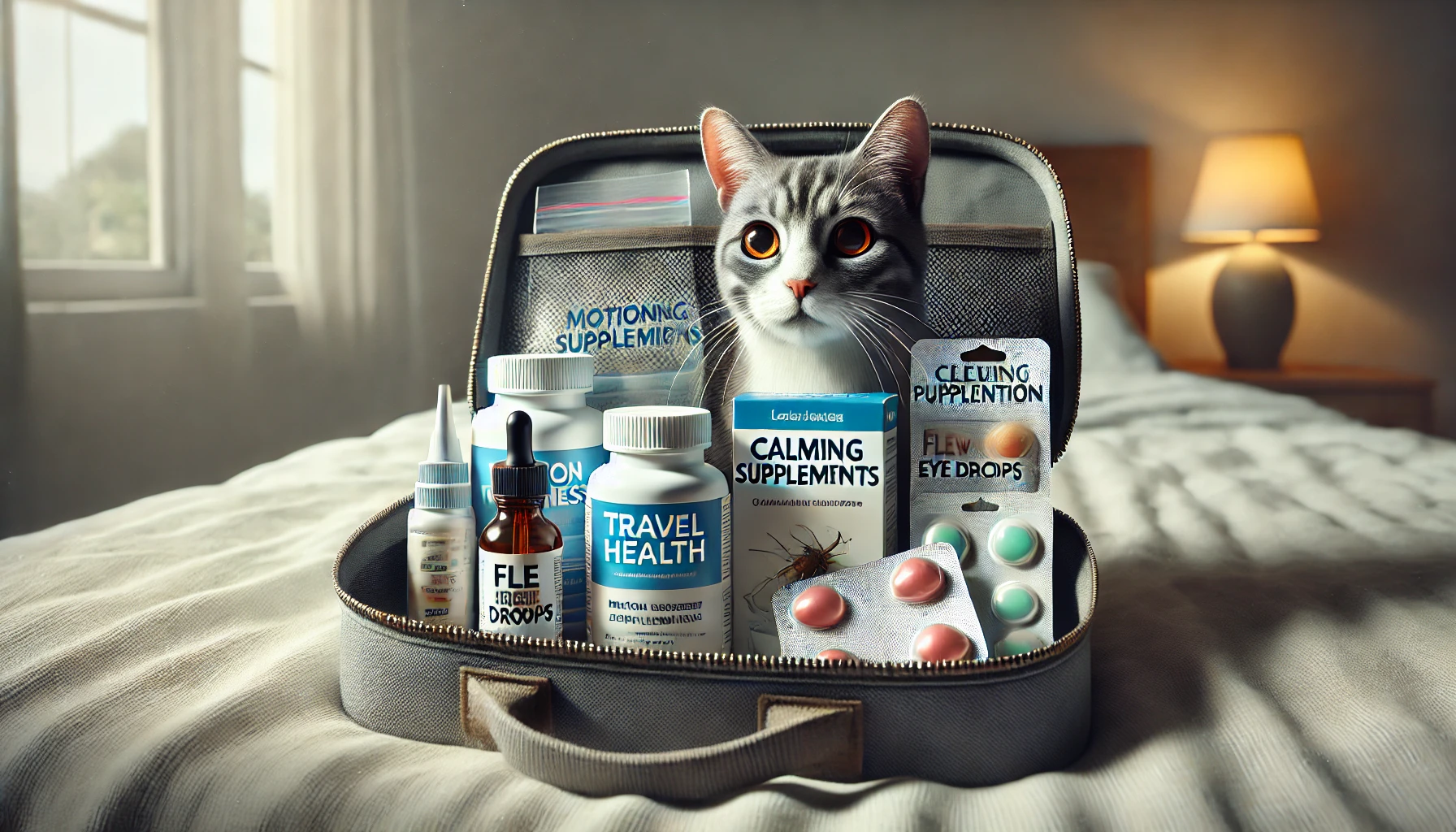
Travel-Specific Health Items
When you’re on the road, there are additional health-related cat essentials you’ll want to have on hand to keep your cat healthy and happy throughout the trip.
This category includes:
- Motion sickness medication: If your cat tends to get carsick or airsick, consult your vet about medicating your cat with a nausea-prevention drug that is safe for cats.
- Calming treats or supplements: Calming treats or supplements can help ease your cat’s travel anxiety. Choose natural versions containing ingredients like L-theanine or valerian root.
- Eye drops: Dust or allergens during the journey can cause eye irritation. Carry cat-safe eye drops to soothe any irritation your cat may develop.
- Flea and tick prevention: If you’ll be spending time outdoors, ensure your cat is protected from fleas and ticks. Pack topical treatments or flea collars designed for traveling cats to keep pests at bay.

Preparing for Emergency Situations
The most important thing while traveling with your cat is being prepared in case of emergencies.
While you may hope not to use your first-aid kit, it’s crucial to know how to handle common emergencies.
Consider the following:
- Know your cat’s normal behavior: Understanding your cat’s usual behavior and communication style will help you quickly detect if something is wrong. Watch for signs of unease or illness during the trip.
- Have emergency contact information: Always carry your vet’s contact information, along with the addresses and phone numbers of local emergency vet clinics at your destination.
- Basic first-aid knowledge: Familiarize yourself with basic first-aid procedures for cats, such as handling choking, bleeding, or overheating. Consider taking a pet first-aid course before you travel.

Important Contact Information to Carry
In case of an emergency, having important contact information readily available is crucial.
Be sure to carry the following details:
- Veterinarian contact info: Keep your regular veterinarian’s phone number and email handy in your phone or written down. If traveling far, research nearby vets or emergency clinics at your destination and bring their contact details.
- Poison control hotline: Carry the contact information for a pet poison control hotline, such as the ASPCA Animal Poison Control Center, in case your cat ingests something harmful during the trip.
- Pet insurance information: If you have pet insurance, make sure to have a copy of your policy number and claims contact information on hand in case of an emergency.
A well-stocked first-aid kit is crucial for handling any emergencies on the go. Don’t forget essential medical supplies like bandages, antiseptics, and flea prevention products.
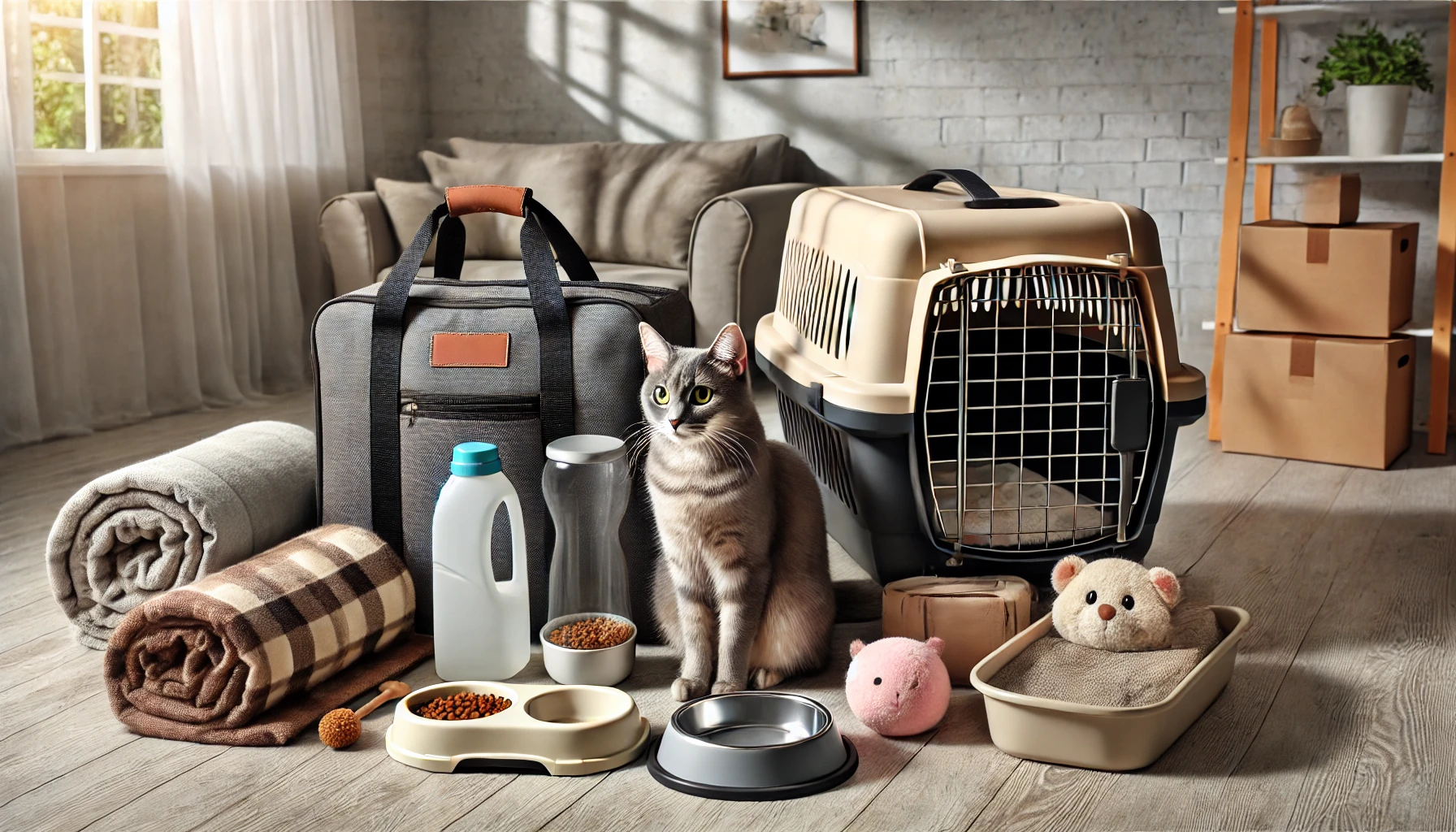
Final Thoughts on What to Pack for Cats for a Seamless Relocation
Traveling with your cat can be extremely rewarding if you are well prepared and pack the appropriate cat essentials ahead of time.
Keeping your feline companion comfortable, safe, and well-cared for throughout the trip does require some time and preparation, but it is well worth it.
By focusing on their food, hydration, comfort, hygiene, and medical needs, you can ensure your cat feels at home, even in a new environment.

Key Takeaways for Packing Cat Essentials
Below are some key takeaways when packing for your trip with your cat:
- Comfort Items: Pack all bedding and comfort items your cat is used to. Bring interactive toys to keep them entertained during the journey.
- Food and Water: Take your cat’s regular food and water to help avoid stomach problems. Collapsible bowls and airtight containers are convenient for travel.
- Hygiene: A portable litter box and litter disposal bags are essential for cleanliness on the go. Grooming tools such as brushes, wipes, and nail clippers will help keep your cat looking and feeling their best.
- First-Aid Kit: A basic first-aid kit with bandages, antiseptic wipes, and motion sickness medication is important. Being prepared for emergencies will give you peace of mind during your trip.
- Emergency Contacts: Always carry your veterinarian’s contact information as well as the contact information for vets near your destination.
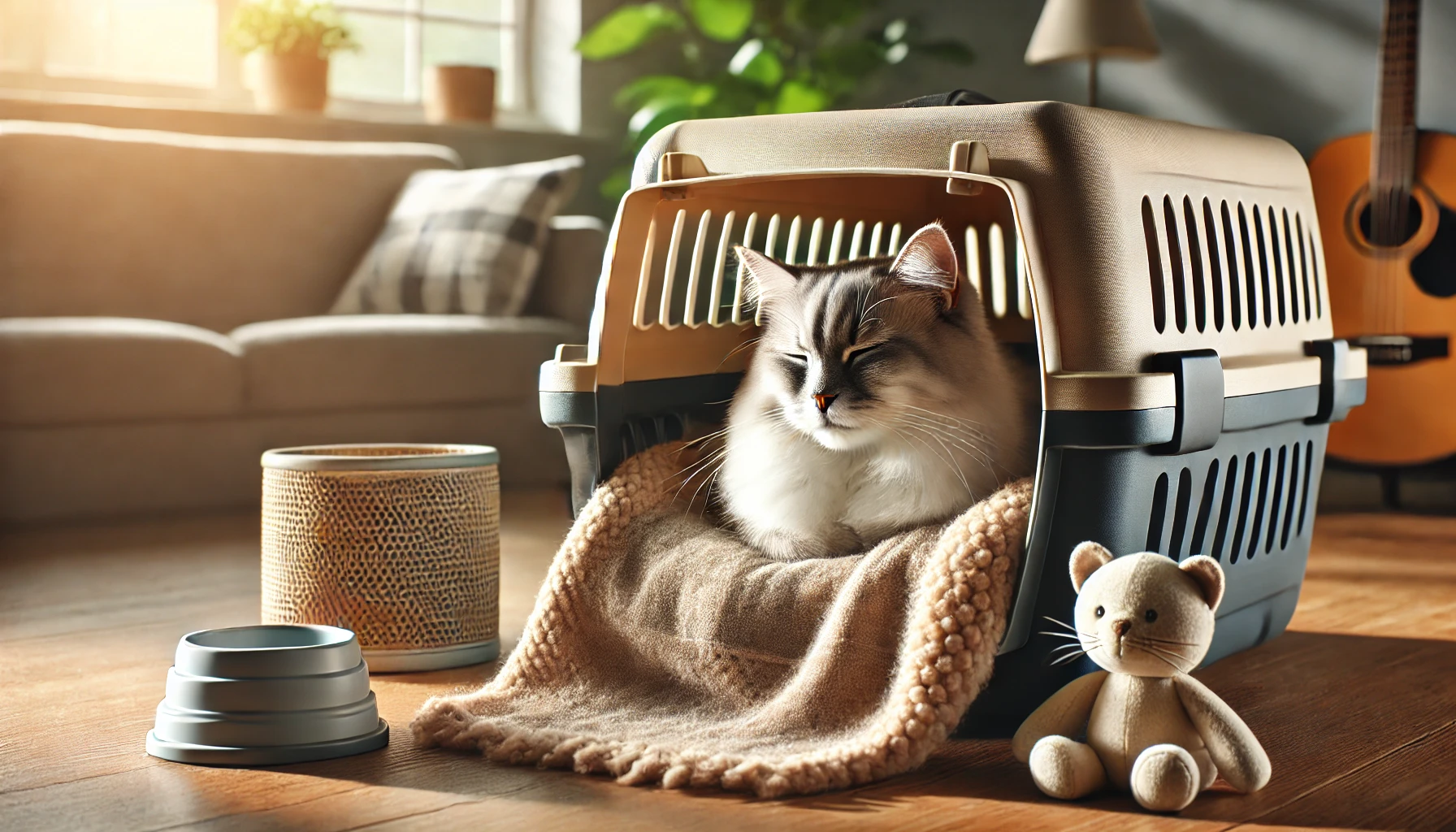
Making the Trip Stress-Free for Your Cat
To minimize stress for your cat, adhere to these precautions: since cats thrive on routine and familiarity, replicating their home environment as much as possible is key to a smooth travel experience.
Pack items your cat loves, such as comforting bedding, their usual food, and essential hygiene items to create a secure and comfortable atmosphere for your pet.
Along the way, be sure to be patient and understanding.
Reassure your cat with plenty of attention, as some cats may take a little time to adjust to new surroundings.
With proper preparation and care, you can ensure a successful and stress-free journey with your cat.
By ensuring you pack all the right cat essentials, you can make your trip stress-free and enjoyable for both you and your cat.
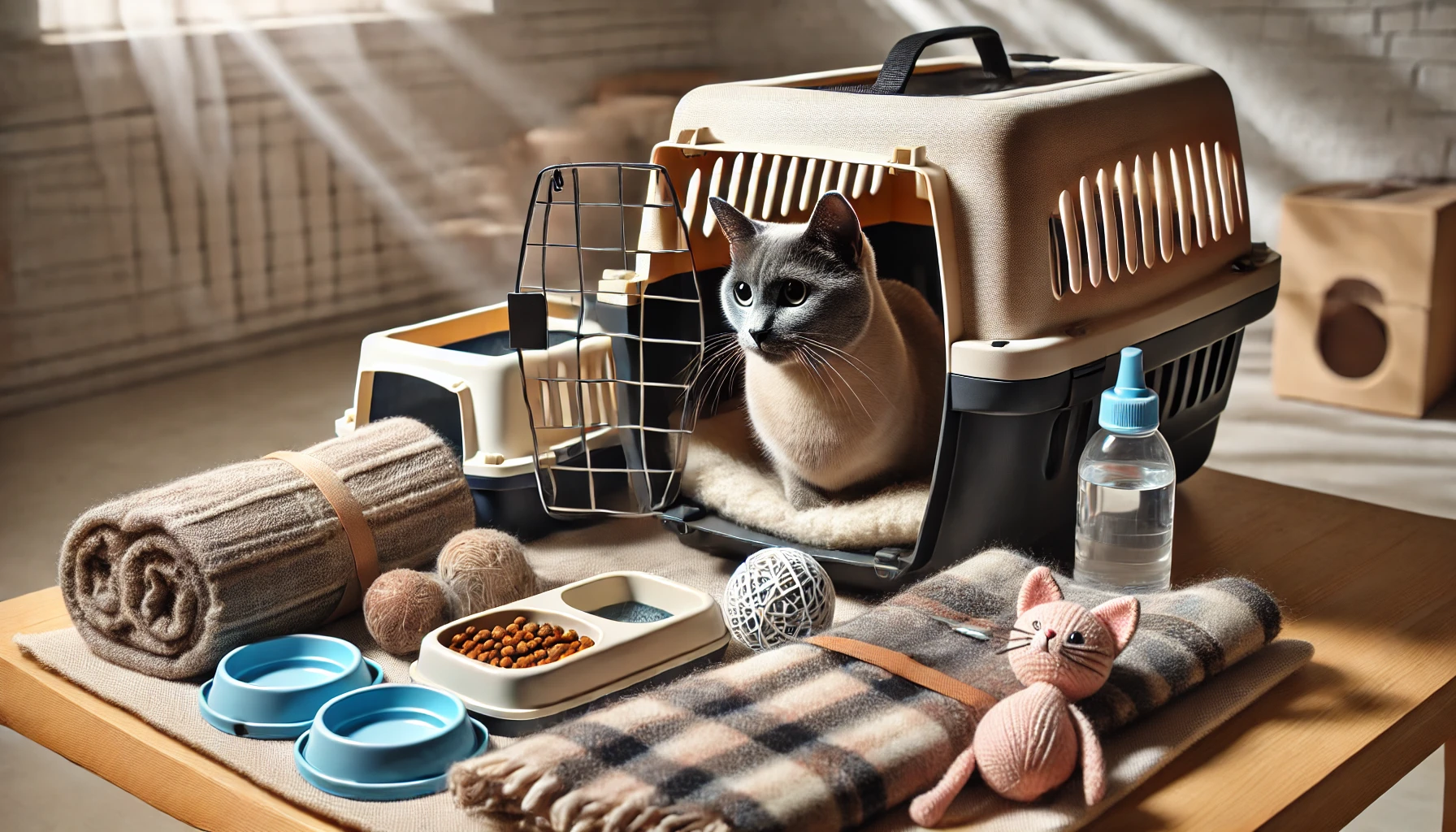
Packing the Essentials for Cat Trips – Commonly Asked Questions
Below are some commonly asked questions and answers regarding the essential cat essentials to pack for a smooth and comfortable journey with your cat.
What may I need to travel with a cat?
The essentials include a travel carrier, bedding your cat is used to, food and water, a portable litter box, grooming tools, a first-aid kit, and your cat’s regular medication to ensure comfort and safety during the trip.
How can I keep my cat calm during the journey?
Bring your cat’s familiar bedding and toys, use calming sprays, and maintain as much of a regular routine as possible.
Consider using calming treats.
Always provide a safe, quiet environment and plenty of reassurance throughout the journey.
What type of food should I take for my cat when traveling?
Always take your cat’s regular food to avoid digestive upset.
Dry food or canned food can be packed in airtight containers.
For longer trips, single-serve packets or freeze-dried foods are less wasteful and easy to feed.
How can I ensure my cat does not become dehydrated during travel?
Bring bottled or filtered water, as cats may refuse unfamiliar water.
Collapsible bowls or pet water bottles are convenient for on-the-go hydration and easy to store during the trip.
What should I include in a first-aid kit for my cat?
Include bandages, antiseptic wipes, a digital thermometer, tweezers, styptic powder, and any prescribed medications.
Consider adding motion sickness medication and flea prevention if your cat will be exposed to outdoor environments.
Do I need to bring a litter box for a short drive?
Yes, even for short journeys, a portable litter box is important.
Cats need a familiar place to relieve themselves, and having one will reduce their stress and help maintain cleanliness during the trip.





